Breaking Markets – The Bear Awakens
From last week:
“Over the last couple of months, I have repeatedly discussed the deterioration of market breadth, momentum and the fundamental backdrop of the markets.
Read the following posts to catch up:
Along with these warnings, I have continually suggested a health regimen of portfolio rebalancing, profit taking and risk controls in this weekly missive: To wit:
- Trim back winning positions to original portfolio weights: Investment Rule: Let Winners Run
- Sell positions that simply are not working (if the position was not working in a rising market, it likely won’t in a declining market.) Investment Rule: Cut Losers Short
- Hold the cash raised from these activities until the next buying opportunity occurs. Investment Rule: Buy Low
As I have discussed many times in the past, the trend of the market is still positive and there is no reason to become extremely defensive as of yet. However, this does not mean to become complacent in your portfolio management practices either.”
It is that last paragraph that I want to focus on with you today.
No Bull, No Bear
Let me clarify something before I go further into this week’s missive.
In the media, and on Wall Street, there is an overwhelming push to classify views as either bullish or bearish. This is a VERY dangerous thing for investors.
The reason I say this is that since, in the words of Bob Farrell, “bull markets are more fun than bear markets,”investors tend to seek out “bullish” commentary to support their “hopes” of a continually rising bull market. The danger, as I have addressed in the past, is that individuals become “willfully blinded” to data that does not conform to their personal biases. This bias of seeking out only “confirming data,” known as confirmation bias, leads to decision making that is ultimately prone to error.
While I am personally tagged as a “bear” because I discuss not so optimistic views of the market and point out inherent risk, I assure you I am NOT a bear. I am also NOT a bull. I simply look at the relevant data and make determinations of risk based on historical precedents and statistical data.
As a portfolio manager of OTHER PEOPLE’S money, my biggest concern is not how much money I can make during market advances, but rather how much I keep from losing during market declines. While this seems counter-intuitive, it reality it is where long-term gains are actually generated. As William Lippman once quipped:
“Better to preserve capital on the downside rather than outperform on the upside”
However, it is this focus on capital conservation and risk management that gets me habitually tagged as a “bear.” If that is the case, so be it – I will gladly wear that moniker if that leads to better outcomes for those I work for.
The reason, I say this is because it simply comes down to the math. As I wrote last week:
“The reason that portfolio risk management is so crucial is that it is not “missing the 10-best days” that is important, it is “missing the 10-worst days.” The chart below shows the comparison of $100,000 invested in the S&P 500 Index (log scale base 2) and the return when adjusted for missing the 10 best and worst days.”
(Click on image to enlarge)
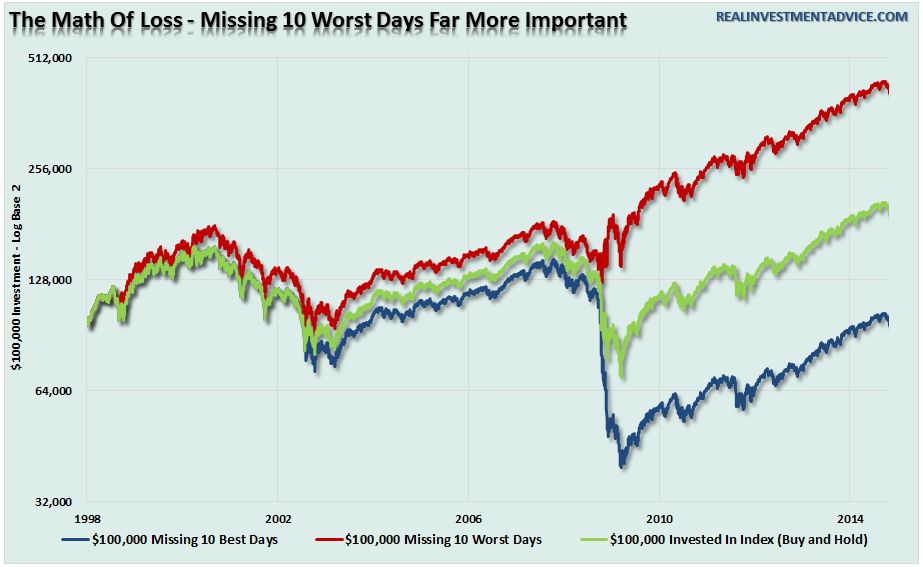
“Clearly, avoiding major draw-downs in the market is key to long-term investment success. If I am not spending the bulk of my time making up previous losses in my portfolio, I spend more time compounding my invested dollars towards my long-term goals.”
Let me reiterate this point. A strict discipline of portfolio risk management will NOT eliminate all losses in portfolios. However, it will minimize the capital destruction to a level that can be dealt with logically, rather than emotionally.
In the end, it does not matter IF you are “bullish” or “bearish.”The reality is that both “bulls” and “bears” will be owned by the full-market cycle. However, what is grossly important in achieving long-term investment success is not necessarily being “right” during the first half of the cycle, but by not being “wrong” during the second half.
The Bullish Trend Is Broken
Investing is really pretty basic and defined by two simple rules as defined by Dennis Gartman:
“In bull markets we can only be long or neutral, and in bear markets, we can only be short or neutral. That may seem self-evident; it is not, however.”
This is critically important to understand considering that the markets have very likely broken the bullish trend that begin in 2009. Take a look at the first chart below.
(Click on image to enlarge)
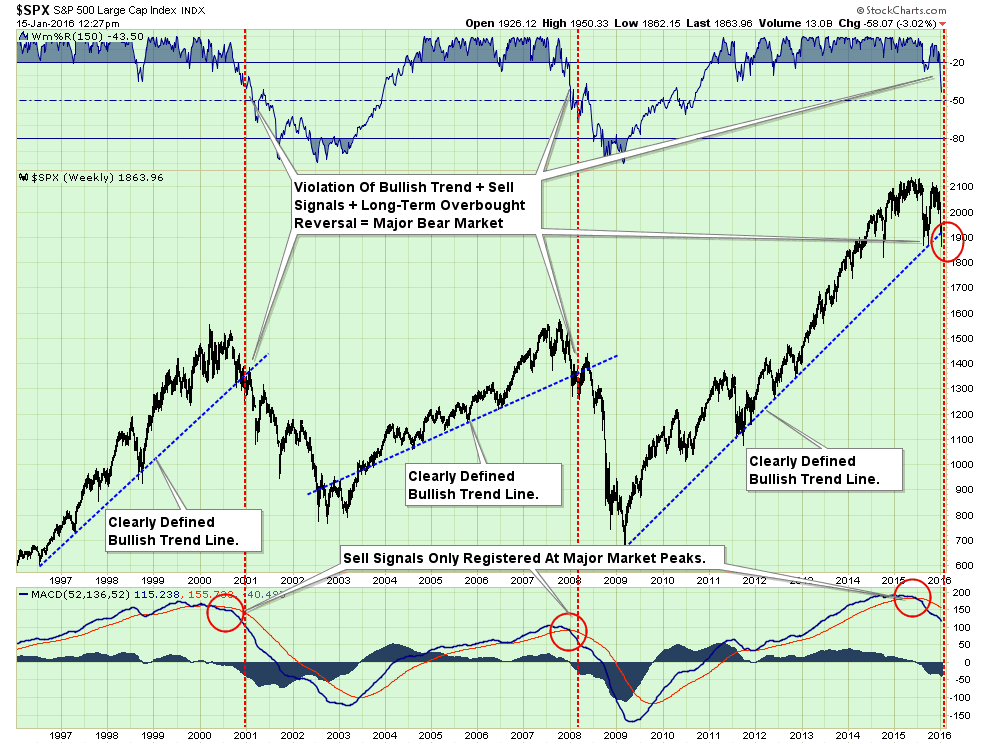
This “weekly” chart of the S&P 500 shows the bullish trends which were clearly defined during their advances in the late 1990’s, 2003-2007 and 2009-present. Each of these bullish advances, despite ongoing bullish calls to the contrary, ended rather badly with extremely similar circumstances: technical breakdowns, weakening economics, and deteriorating earnings.
As I have shown in the chart above, when the markets broke the bullish trends (blue dashed lines), the subsequent bear market occurred rather rapidly. The conversion from the bull market to the bear market was marked by a breakdown in prices and the issues of a very long-term “sell signal” as noted in the bottom of the chart.
We can look at this same analysis a little differently and see much of the same evidence.
(Click on image to enlarge)
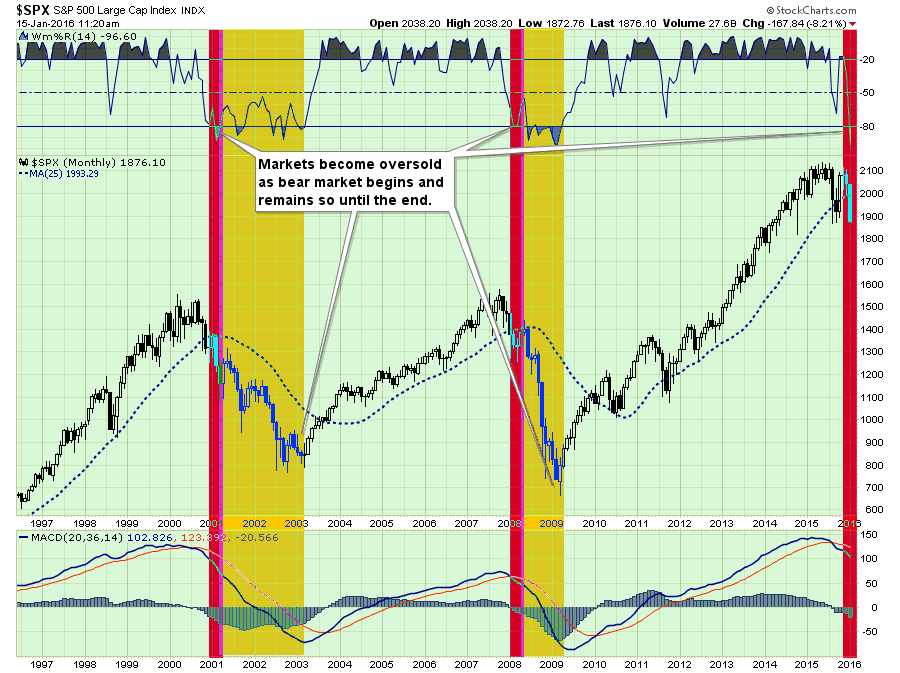
The chart above shows something I discussed this past week:
“Markets crash when they’re oversold.”
When markets break their long-term bullish trend supports combined with important long-term sell signals and a sharp decline in momentum, it has historically denoted the start of a “bearish market trend.” The red highlight denotes the start of the bear market and the yellow highlight shows the ensuing bear market completion. They are swift and brutal.
The next chart, which is the same as above, completes the analysis by pointing out the important signals showing the change in trend.
(Click on image to enlarge)

Don’t Panic, Walk To The Exits
I know as I write this, that come Monday morning my inbox will be flooded with emails asking if its time to go to “all cash.”
No. I NEVER suggest being in “all cash.” From a management standpoint, this is never a good idea. Trying to “time the market” is impossible over the long-term and leads to very poor emotionally based decision making. However, as I regularly write, it is our job to reduce portfolio risk to manageable levels to preserve capital over time. We can do that by increasing and reducing our exposure to equity-related risk by paying attention to the price trends of the market.
By the time the markets register important “sell signals” denoting a change from the bullish to bearish trend, the markets are generally oversold from the previous selling. This is, as shown in the chart below, always the case.
(Click on image to enlarge)
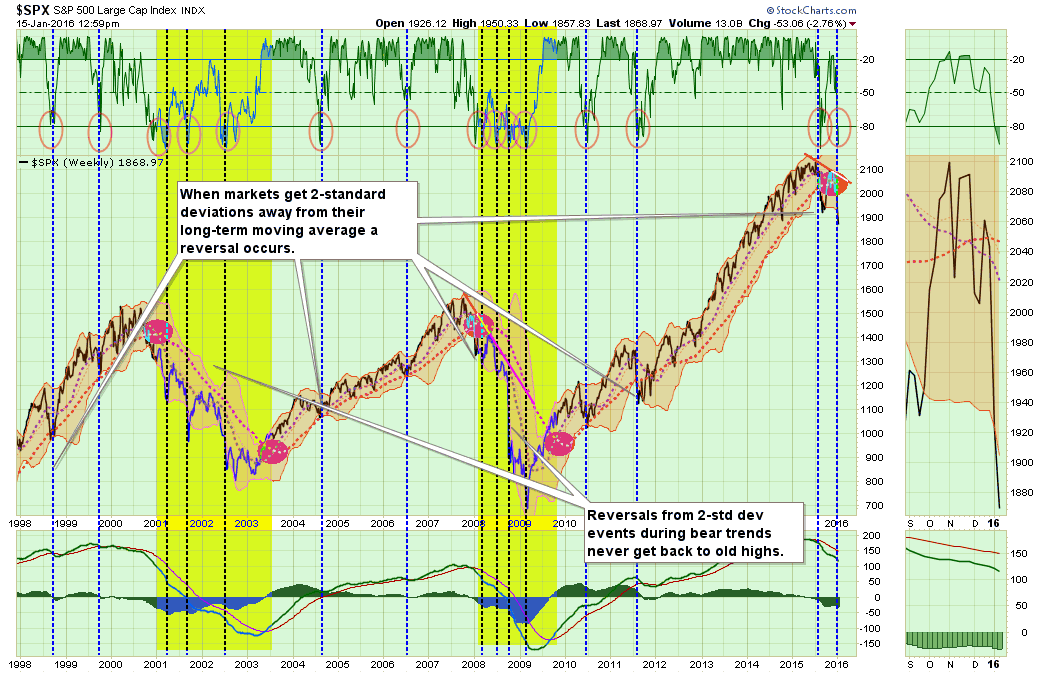
(Note: I am using weekly data to smooth volatility)
The top section of the chart is a basic “overbought / oversold” indicator with extreme levels of “oversold” conditions circled. The shaded area on the main part of the chart represents 2-standard deviations of price movement above and below the short-term moving average.
There a couple of very important things to take away from this chart. When markets begin a “bear market” cycle[which is identified by a moving average crossover (red circles) combined with a MACD sell-signal (lower part of chart)], the market remains in an oversold condition for extended periods (yellow highlighted areas.)
More importantly, during these corrective cycles, market rallies fail to reach higher levels than the previous rally as the negative trend is reinforced. All of these conditions currently exist.
Does this mean that the markets will go straight down 20% without a bounce? Anything is possible. However, history suggests that even during bear market cycles investors should be patient and allow rallies to occur before making adjustments to portfolio risk. More often than not, it will keep you from panic selling a short-term market bottom.
THE MONDAY MORNING CALL
Markets At Support
As noted above, the markets are registering the first confirmed set of monthly SELL signals since the peak of the market in late 2007. As I have stated repeatedly: Don’t Panic Sell
Take a look at the chart below.
(Click on image to enlarge)
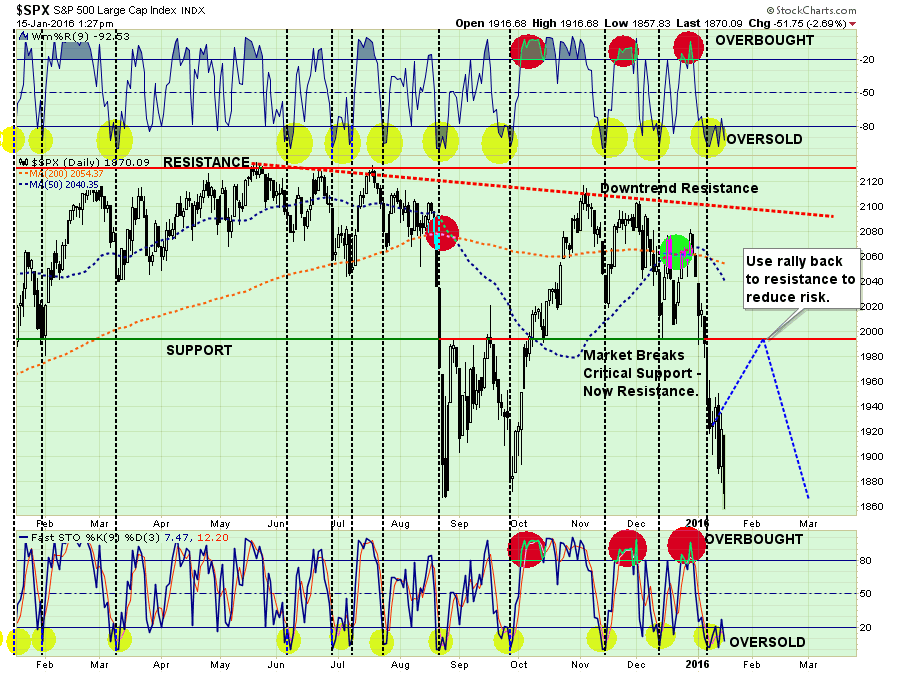
In particular note the top and bottom portions of the chart. These two indicators measure the “over bought” and“over sold” conditions of the market. You will notice that when these indicators get stretched to the downside, there is an effective “snap back” in fairly short order.
As I stated last week, chart updated from then:
“With the markets having issued multiple sell signals, broken very important support and both technical and fundamental deterioration in progress, it is suggested that investors use these “snap back” rallies to reduce equity risk in portfolios.
Let me provide you again with the rebalancing rules that I reiterated through the majority of last years newsletters as markets deteriorated from the May-June highs. That period also marks the point where I reduced equity risk in portfolios by 50% (which is where it remains currently.)
1) Trim positions that are big winners in your portfolio back to their original portfolio weightings. (ie. Take profits)
2) Positions that performed with the market should also be reduced back to original portfolio weights.
3) Move trailing stop losses up to new levels.
4) Review your portfolio allocation relative to your risk tolerance. If you are aggressively weighted in equities at this point of the market cycle, you may want to try and recall how you felt during 2008. Raise cash levels and increase fixed income accordingly to reduce relative market exposure.”
How you personally manage your investments is up to you, and I am only suggesting a few guidelines to rebalance portfolio risk accordingly. However, the risk of being long a tremendous amount of equity risk is no longer as advantageous as it once was.
This could all change, of course, if the Federal Reserve leaps into action with a rate cut, another liquidity program or direct market intervention. However, until that happens, it is better to be safe than sorry.
Working With A Model Allocation
Let’s review the model.
Note: The following is for example purposes ONLY. It is in no way a suggestion, recommendation, or implication as to any portfolio allocation model currently in use. It is simply an illustration of how to overweight or underweight a model allocation structure.
Again, this is just for educational purposes, and I am not making any specific recommendations. This is simply a guide to assist you in thinking about your own personal position, how much risk you are willing to take and what your expectations are. From that starting point design a base allocation model and weight it accordingly. The closer you want to track the S&P 500 Index, the less fixed income, real estate and cash your portfolio should have. For a more conservative allocation reduce allocations to equities.
Got it? Okay.
S.A.R.M. Current
The Sector Allocation Rotation Model (SARM) is an example of a basic well-diversified portfolio. The purpose of the model is to look “beneath the hood” of a portfolio to see what parts of the engine are driving returns versus detracting from it. From this analysis, we can then determine where to overweight sectors which are leading performance, reduce in areas lagging, and eliminate those areas that are dragging.
The Sector Allocation Rotation Model continues to deteriorate suggesting that markets are significantly weaker than they appear. As suggested all through this missive, a reflexive bounce in the market should be SOLD into currently.
(Click on image to enlarge)
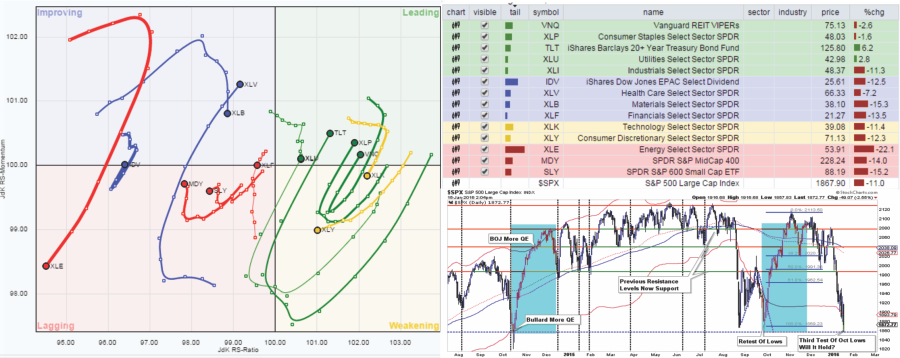
In a quick reversal from last week, the defensive sectors of REIT’s, Utilities, Bonds, and Staples have become safe havens for capital as previous leaders of Technology and Discretionary sectors have come under pressure. Energy remains a disaster along with Mid and Small-Cap indices. Health care, Materials, and Industrials are improving by not losing as much.
Portfolio equity models that rotate sectors (offense to defense) do not work in bear markets.
Below is sector performance from last week:
(Click on image to enlarge)
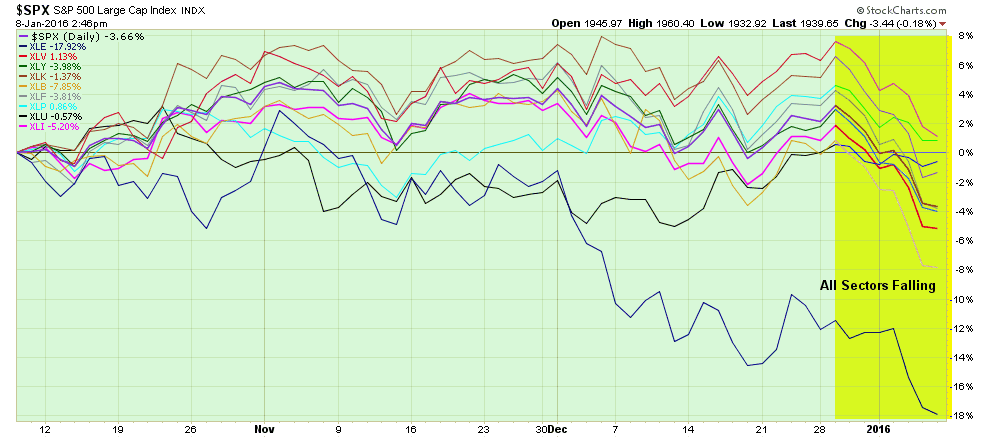
It has gotten worse this week. NO sectors have a positive return.
(Click on image to enlarge)
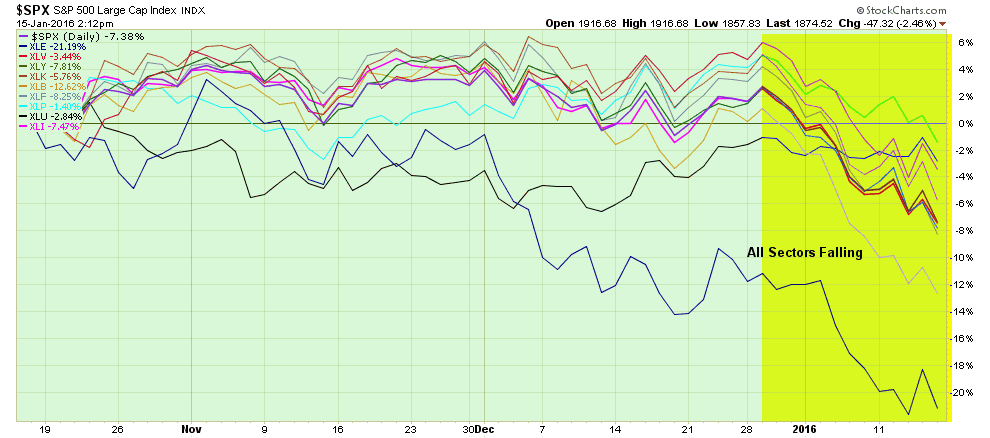
The call for fixed income to go below 2% this year is rapidly coming to fruition. Hold off adding to fixed income for now. Hold current allocations for now and add to positions when the equity market bounces.
(Click on image to enlarge)
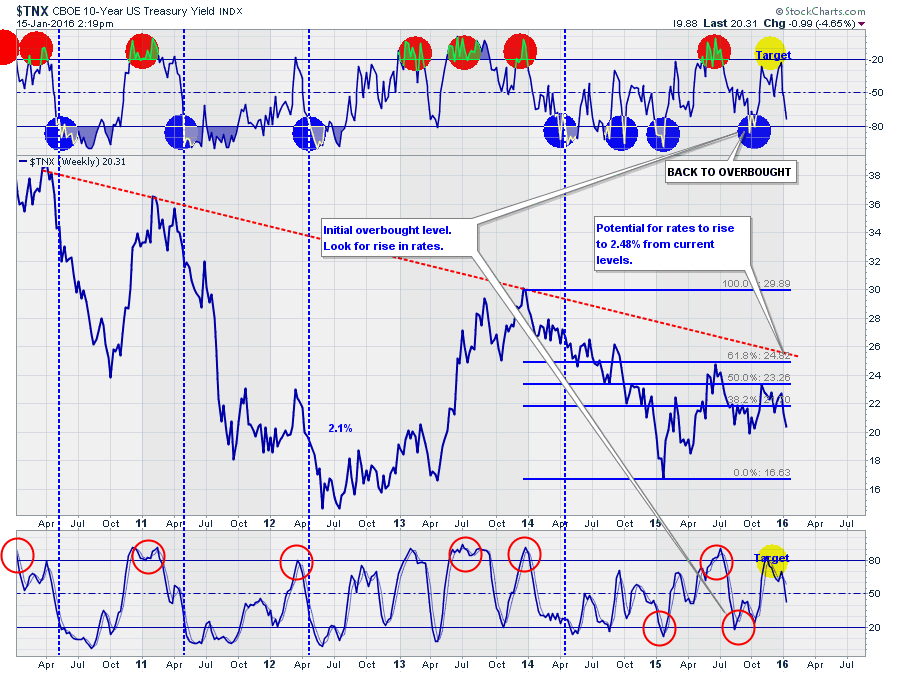
Energy has now broken all levels of support and is likely headed lower. Remain out of the energy sector, for now, including MLP’s. Use rallies toward $60 (XLE) to reduce exposure, the new target is likely in the mid to low $40’s.
(Click on image to enlarge)
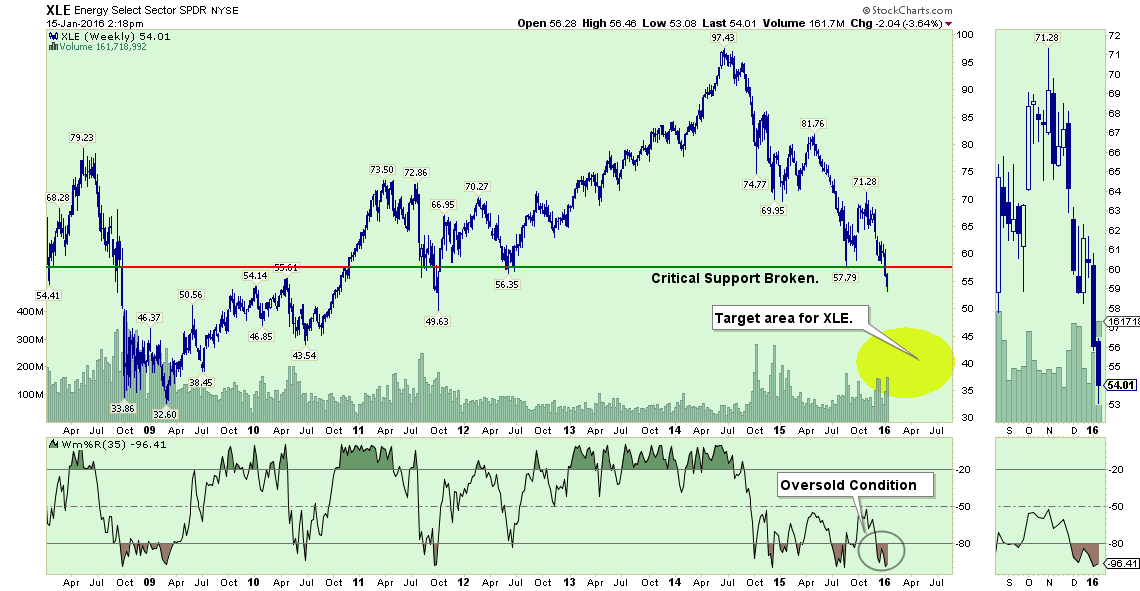
The recommendations for “pruning and trimming” exposure over the past couple of months has already done much of the risk mitigation needed to navigate the current markets. Therefore, there should be only relatively minor changes needed currently.
S.A.R.M. Model Allocation
Hold current allocations for now. As I have suggested repeatedly throughout this missive, use a bounce in the market to reduce equity risk exposure. I have set the SARM Model to reflect the allocation model following the expected short-term bounce.
- Reduce Materials
- Reduce Industrials
- Reduce Discretionary
- Eliminate Energy
- Reduce Technology
- Add Utilities
- Hold Staples
- Reduce Healthcare
- Reduce Financials
- Hold REITs
- Add Bonds
The example portfolio currently looks as follows:
(Click on image to enlarge)

After a reflexive bounce in the market it will adjust as follows:
(Click on image to enlarge)
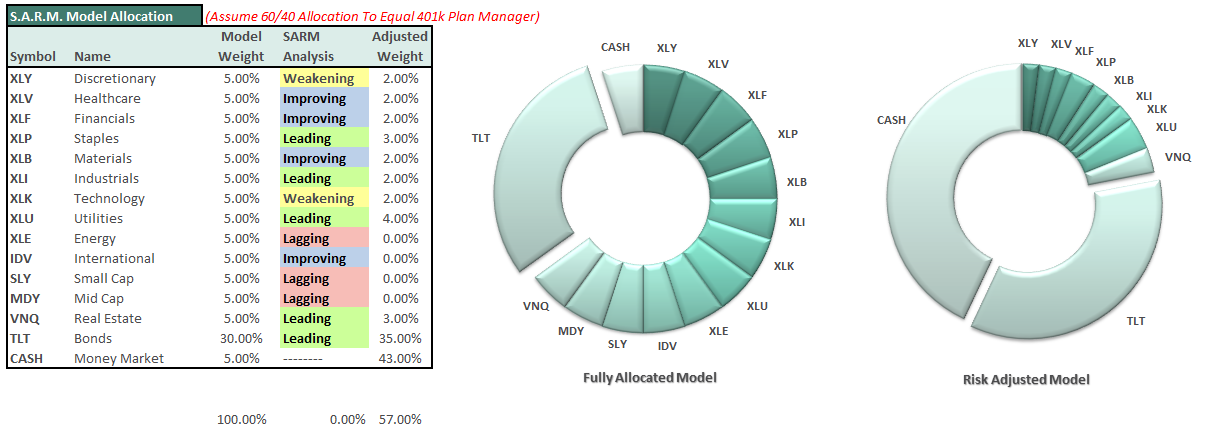
Again, with the sell-0ff this week, the markets are oversold enough to elicit a short-term rally over the next week or so. As you will notice, the model is currently carrying 35% cash in the portfolio. Any rally in the markets should be used to increase cash accordingly.
It is completely OKAY if your current allocation to cash is different based on your personal risk tolerance.
As you can see, there are not DRASTIC movements being made. Just incremental changes to reducing overall portfolio volatility risks. However, if the expected bounce fails at resistance, then further reductions will be required in accordance with the risk reduction modeling.
Remember, as investors, our job is not to try and capture every single relative point gain of the market as it rises. While we certainly want to participate in the rise, our JOB is to protect our capital against substantial losses in the future. A methodology that regularly harvests gains, reduces risk and keeps the portfolio focused on longer-term goals will lead to a more successful outcome.
The Real 401K Plan Manager
(Click on image to enlarge)
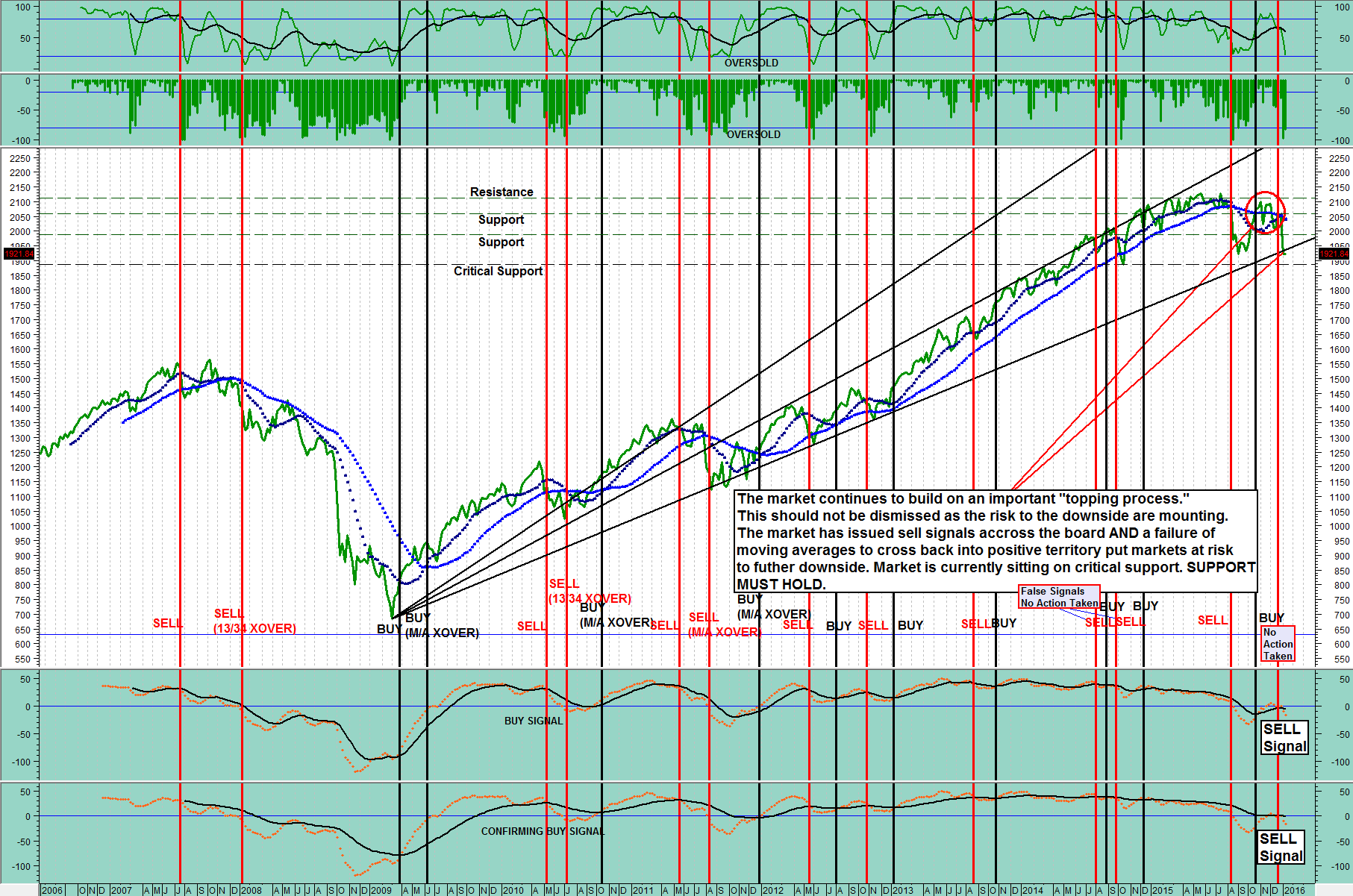
Market Failing – Caution Advised
As discussed above, the market is threatening to break to the long-term trend support. A change in TREND is criticaland suggests that the bull market advance that began in 2009 is over. As shown in the chart above, the technical deterioration is significant.
I continue to advise caution.
The 401k Model is NOT being tactically adjusted at this time because the markets are VERY OVERSOLD on a short-term basis. Over the next week or so the markets will likely rally to towards previous resistance at 1990 on the S&P 500. This level should be used to reduce portfolio equity risk to the current model levels.
ON ANY RALLY NEXT WEEK – I will reduce the allocation model further to just 15% equity exposure. (This is the lowest level the model goes.)
The current market environment is NOT conducive for an overweight allocation to equity risk currently.
Portfolio management rules still apply for now. If the recent market volatility has made your nervous as of late, you are probably carrying too much risk in your portfolio.
As always, your portfolio, much like a garden, must be tended too in much the same way. By doing so, it will ensure that it prospers and grows over time and yields a fruitful bounty.
- HARVEST: Reduce “winners” back to original portfolio weights. This does NOT mean sell the whole position. You pluck the tomatoes off the vine, not yank the whole vine out of the ground.
- WEED: Sell losers and laggards and remove them garden. If you do not sell losers and laggards, they reduce the performance of the portfolio over time by absorbing “nutrients” that could be used for more productive plants. The first rule of thumb in investing “sell losers short.” So, why are you still hanging onto the weeds?
- FERTILIZE AND WATER: Add savings on a regular basis. A garden cannot grow if the soil is depleted of nutrients or lost to erosion. Likewise, a portfolio cannot grow if capital is not contributed regularly to replace capital lost due to erosion and loss. If you think you will NOT EVER LOSE money investing in the markets…then STOP investing immediately.
- WATCH THE WEATHER: Pay attention to markets. A garden can quickly be destroyed by a winter freeze or a drought. Not paying attention to the major market trends can have devastating effects on your portfolio if you fail to see the turn for the worse. As with a garden, it has never been harmful to put protections in place for expected bad weather that didn’t occur. Likewise, a portfolio protected against “risk” in the short-term, never harmed investors in the long-term.”
If you need help after reading the alert; don’t hesitate to contact me.
Current 401-k Allocation Model
(Click on image to enlarge)

401k Choice Matching List
(Click on image to enlarge)

Disclosure: The information contained in this article should not be construed as financial or investment advice on any subject matter. Streettalk Advisors, LLC expressly disclaims all liability in ...
moreComments
 No Thumbs up yet!
No Thumbs up yet!



